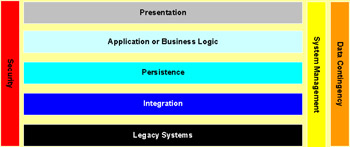Chapter 10: System Management
System management is a critical discipline for any e-business solution. It involves pre-implementation and post-implementation activities. The pre-implementation activities are part of the design phase and occur during the deployment of the solution. The post-implementation activities occur on a routine basis and do not really begin until an application has been deployed into a production environment. This chapter covers the pre- and post-implementation system management design, technologies and activities.
10.1 System management activities
The multi- tier model provides the separation of the presentation, business logic, persistence and integration components of an application, facilitating the system management and data contingency. Figure 10-1 shows that it was complemented with two new tiers:
-
System Management: this tier is responsible for the components that will manage the solution. The management range goes from solution availability, performance evaluation and alert generation to software distribution and inventory management.
-
Data Contingency: this tier is responsible for back-up/restore of the solution.

Figure 10-1: n-tier model with System Management and Data Contingency
System management can be divided into pre- and post-implementation activities:
-
Pre-implementation activities occur during the Solution Design phase and involves the answer of some questions that will drive the post-implementation activities. These answers are very related to availability requirements and used technologies. Some of these questions are:
-
Does the solution need management? Is it critical? What are the impacts of service outage ?
-
What level of management is needed for each component? It is interesting to analyze each isolated component and qualify how critical that component is to the solution, considering technical and business issues. The main components are:
-
WAN and LAN Connectivity
-
Security
-
Server hardware resources
-
Operating systems
-
Foundation software, like WebSphere Application Server
-
On-the-shelf applications, like WebSphere Portal Server
-
Developed applications
-
Databases
-
Clusters
-
Storage
-
-
How much money can be spent on system management? Is it worth it to manage a specific component if the cost for it is particularly high? What are the benefits of each component in business and technical terms of management?
-
Is data contingency by implementing a back-up and restore policy necessary? Is an online and totally automatized process needed?
-
Is a disaster recovery solution necessary?
-
Will the development and testing of new applications be in-house?
-
Will the stage be in-house?
-
What will be the process to develop an application, stage and deploy it in the production environment?
-
What is the required Service Level Agreement (SLA) established between the users and the solution provider? SLAs cover system availability hours, system utilization and problem resolution response time.
With the answers to some of these questions, it is possible to design a solution that supports and implements the required level of system management. Part of the design phase includes matching the solution requirements, the existing tools and technologies, and the cost of the solution. From this matching, the solution that best fits the technical and business requirements can be developed.
-
-
Post-implementation activities occur after the solution is deployed. These activities require highly specific skills and professional experience to perform competently. Some of the core activities that are performed depending on the required level of system management are:
-
Application management
-
Performance monitoring
-
Availability management
-
Security management
-
Disaster recovery
-
Operating system and network administration
-
Asset management
-
Software distribution
-
Problem reporting
-
Change management
-
A detailed explanation of each pre- and post-implementation activity is beyond the scope of this redbook. Our focus is on the key system management activities related to the implementation of WebSphere Everyplace Access and its components for a Pervasive Portal solution.
EAN: 2147483647
Pages: 83